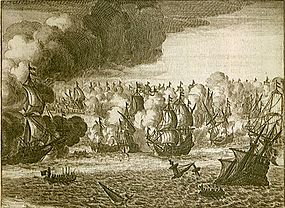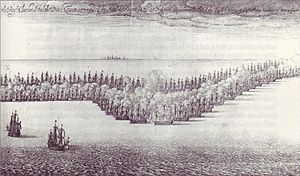St. James' Day Battle facts for kids
Quick facts for kids St James' Day Battle |
|||||||
|---|---|---|---|---|---|---|---|
| Part of the Second Anglo-Dutch War | |||||||
 Engraving showing the St. James Day battle August 4th, 1666, between English and Dutch ships |
|||||||
|
|||||||
| Belligerents | |||||||
| Commanders and leaders | |||||||
| Prince Rupert George Monck |
Michiel de Ruyter | ||||||
| Strength | |||||||
| 90 ships 16 fireships |
89 ships 20 fireships 9 yachts |
||||||
| Casualties and losses | |||||||
| 1 ship sunk c. 300 killed |
2 ships captured c. 800 killed |
||||||
The St James' Day Battle was a big naval fight that happened on July 25, 1666. It's also known as the Battle of the North Foreland. This battle was part of the Second Anglo-Dutch War, a series of conflicts between England and the Dutch Republic.
The English fleet was led by two important commanders, Prince Rupert of the Rhine and George Monck, the Duke of Albemarle. On the other side, the Dutch fleet was commanded by Lieutenant-Admiral Michiel de Ruyter, a famous naval leader. In the Netherlands, this battle is sometimes called the Two Days' Battle.
Contents
The St James' Day Battle
This battle happened not long after another big fight called the Four Days' Battle, which the Dutch had mostly won. Both sides were ready for another major clash at sea.
The First Day of Fighting
On the morning of July 25, 1666, the Dutch fleet, with 88 ships, found the English fleet of 89 ships near North Foreland. The English were sailing north. The wind was blowing from the northwest, which meant the Dutch were "leeward" (downwind) and the English were "weather gauge" (upwind), giving the English an advantage.
Suddenly, the wind changed direction to the northeast. Prince Rupert of the Rhine, the English commander, quickly turned his ships east to get the "weather gauge" again. This meant they would be upwind, which was a better position for attacking. The Dutch commander, De Ruyter, tried to follow, but the wind died down, and his fleet fell behind.
The front part of the Dutch fleet, led by Lieutenant-Admiral Johan Evertsen, became stuck without wind. This caused it to drift away from the main battle line, splitting De Ruyter's fleet in two. This strange situation lasted for hours. Then, a light breeze started blowing again from the northeast.
Right away, the English front ships, led by Thomas Allin, and part of their middle section formed a battle line. They attacked the Dutch front, which was still disorganized. The Dutch struggled to form a proper line, and many of their ships were badly damaged by the English cannons. Vice-Admiral Rudolf Coenders was killed, and Lieutenant-Admiral Tjerk Hiddes de Vries was severely wounded.
De Ruyter tried to bring the middle of his fleet to help the front, but the wind was against him. He couldn't reunite his forces. With the Dutch front defeated, the English ships moved in to finish off De Ruyter's middle section. George Monck thought De Ruyter would quickly retreat, but De Ruyter fought fiercely on his flagship, the De Zeven Provinciën. He bravely faced attacks from two powerful English ships, the Sovereign of the Seas and the Royal Charles. De Ruyter's strong resistance allowed the remaining Dutch ships from the front to escape south.
Meanwhile, Lieutenant-Admiral Cornelis Tromp, who commanded the back part of the Dutch fleet, came to De Ruyter's rescue. Tromp sailed his ships west, cutting across the line of the English rear, which was led by Jeremiah Smith. This cut off the English rear from their main fleet. Tromp's ships then attacked Smith's squadron fiercely, forcing the English ships to flee west.
Tromp chased the English rear late into the night. During this chase, Tromp's ships destroyed the English ship HMS Resolution using a fireship (a ship filled with flammable materials and set on fire to destroy enemy ships). Smith's flagship, HMS Loyal London, caught fire and had to be towed away. The English vice-commander, Edward Spragge, was so upset by this defeat that he became a personal enemy of Tromp.
The Second Day of Fighting
On the morning of July 26, Tromp stopped his chase. He was happy with his victory. During the night, he had received a message saying De Ruyter had also won, which made him feel even better. But his mood changed quickly when he found the drifting flagship of the dying Tjerk Hiddes de Vries. He suddenly worried that his ship was the only one left of the Dutch fleet and that he was in great danger.
Behind him, the English ships that were still working had turned back east. In front, he expected other enemy squadrons. All he could see on the horizon were English flags. Tromp, drinking a lot of gin to calm his nerves, sailed wildly to avoid being trapped. He managed to bring his squadron safely back to the port of Flushing that morning. To his great relief, he found the rest of the Dutch fleet there.
It took Tromp six hours to gather enough courage to face De Ruyter. He knew he should not have gotten so separated from the main fleet. De Ruyter, who was not in a good mood, immediately blamed Tromp for the defeat. He ordered Tromp and his sub-commanders, Isaac Sweers and Willem van der Zaan, away from his sight. He told them never to set foot on De Zeven Provinciën again. The Dutch fleet commander was still very upset from the day before.

On the morning of August 5 (Gregorian calendar), De Ruyter realized his situation was hopeless. Lieutenant-Admiral Johan Evertsen had died. De Ruyter's force was down to about forty ships, many of which were damaged. About fifteen good ships seemed to have left during the night. A strong wind from the east made it hard to retreat to the coast. To the west, the English front and center (about fifty ships) surrounded him in a half-circle, safely firing at him from an upwind position.
De Ruyter felt desperate. When his second-in-command, Lieutenant-Admiral Aert Jansse van Nes, visited him, De Ruyter cried out, "Seven or eight against the whole mass!" He then mumbled, "What's wrong with us? I wish I were dead." His friend Van Nes tried to cheer him up, joking, "Me too. But you never die when you want to!" Right after they left the cabin, a cannonball smashed the table where they had been sitting.
The English, however, also had problems. The strong wind made it hard for them to get close to the Dutch. They tried to use fireships, but these also struggled to reach the enemy. Only a small boat called Fan-Fan, Prince Rupert's personal yacht, rowed towards De Ruyter's flagship, De Zeven Provinciën, to bother it with its two small guns. This made the English crews laugh.
When his ship had again fought off a fireship attack, and Tromp still hadn't appeared, De Ruyter felt unbearable stress. He even tried to get himself killed, standing openly on the deck. When he wasn't hit, he cried out, "Oh, God, how unlucky I am! Among so many thousands of cannonballs, isn't there one that would hit me?" His son-in-law, Captain of the Marines Johann de Witte, heard him and said, "Father, what desperate words! If you just want to die, let's turn around, sail into the middle of our enemies, and fight until we die!" This brave but foolish idea brought the Admiral back to his senses. He realized he wasn't that desperate and replied, "You don't know what you're talking about! If I did that, all would be lost. But if I can bring myself and these ships safely home, we'll finish the job later."
Then, the wind, which had caused so much trouble for the Dutch, saved them by turning to the west. They formed a battle line and brought their fleet to safety through the Flemish shoals (shallow areas of water). Vice-Admiral Adriaen Banckert of the Zealandic fleet protected the retreat of all the damaged ships with the working vessels. The number of working ships slowly grew as it turned out that very few ships had actually left during the night; most had just drifted away and now rejoined the battle.
What Happened After the Battle
The St James' Day Battle was a clear victory for the English. The Dutch had many casualties, with about 1,200 killed or seriously wounded. The English had about 300 killed.
However, England faced its own challenges. The Great Plague of London and the Great Fire of London, along with King Charles II's money problems, meant he didn't have enough funds to keep fighting the war. He had barely enough money for this one last battle.
The Dutch had only lost two ships in total and were able to repair most of their damaged vessels quickly. Within a month, they were back at sea. Later, De Ruyter suffered an injury to his throat but recovered in time to strike a major blow against the English navy in the Raid on the Medway in 1667.
While the Dutch fleet was being repaired, an English admiral named Robert Holmes, with help from a Dutch traitor, attacked the Vlie estuary. He burned a fleet of 150 merchant ships in an event known as "Holmes's Bonfire." He also attacked the town of Ter Schelling.
The defeat also had a big impact on Dutch politics. Tromp was a supporter of the Orangist party. When he was accused of not doing his job well, the country became divided over the issue. Tromp's brother-in-law, Johan Kievit, published a story to defend Tromp. Soon after, Kievit was found to have been secretly talking with the English king about a peace treaty. He fled to England and was sentenced to death in his absence. Tromp's family was fined, and he was not allowed to serve in the fleet. Later, in 1673, the new ruler, William III of Orange, managed to bring De Ruyter and Tromp back together.
See Also
- Glossary of nautical terms : (A–L), (M–Z)
Images for kids


